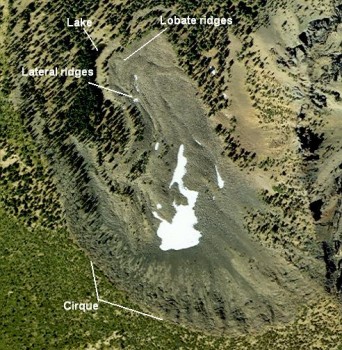Ash Creek Butte Fossil Rock Glacier Geologic Area

Ash Creek Butte Fossil Glacier as seen from above. The cirque is a half a mile wide.
Ash Creek Butte Fossil Rock Glacier Geologic Area occupies a 300-acre site. The remains of an ancient rock glacier sits in a north–facing glacially carved bowl, or “cirque”. A rock glacier is a tongue–like or lobate body, usually of angular boulders, that resembles a small glacier, generally occurs in high mountainous terrain. Ash Creek Butte is an 8,378 foot peak situated on the boundary of Klamath and Shasta–Trinity National Forests. The landforms of Ash Creek Butte record a history of past glaciations.
Geologic Background
As a glacier moves downslope it erodes the landscape, incorporating all sorts of rocks into the ice. The glacier scours a U–shaped valley into the mountainside as it bulldozes nearly everything in its path. After the ice melts away, it leaves behind heaps and furrows of glacially–formed rock debris, generally called moraines.
Surprise Lake and one other small lake in the valley were originally created by glacial meltwater. Because there are no longer active glaciers in the valley, the lakes are now fed by melted seasonal snowpack and rainfall.
Geologic Processes at Work
“Rock glacier” is a controversial term that is ambiguously applied to various geomorphic landforms. In most contexts, the term suggests that a given landform was deposited in conjunction with the movement of ice— either by interstitial, or glacial ice, or by permafrost processes. In other contexts, the term implies that the landform was produced by mass wasting or rockfall.
At Ash Creek Butte, we observe a landform situated in a valley that was once, indisputably, occupied by a glacier. We also see that the high, steep rock face of the cirque surrounds the landform on at least two sides, and that rocks routinely become detached from the walls and tumble to the valley bottom. It is likely that both preexisting ice and current mass wasting processes have contributed to the landform we see here today.
The rock glacier (partially covered by snow) is situated in a north–facing cirque on Ash Creek Butte. The steep cirque walls provided rock material to the rock glacier. Parallel lateral ridges indicate the direction in which the rock glacier moved downslope. Lobate ridges around the perimeter, especially downslope, delineate the terminus of the ancient rock glacier.

Generalized map of the Ash Creek Butte Fossil Glacier.
References
- Christiansen, Robert L., US Geological Survey. Personal communication, 2008.
- Rodoni , Daniel P. “Fossil Rock Glacier on Ash Creek Butte ,” 1990. Ash Creek Butte Geo–SIA, ts. Klamath National Forest–SO, Yreka.


